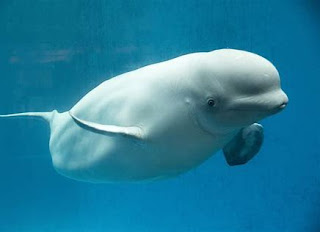Fast Facts: Beluga Whale
The Beluga Whale's plump head makes it look cheerfully smiley all the time. I think this animal exudes cheer and playfulness. Even the name 'Beluga' sounds fun.
The Beluga Whale : Delphinapterus leucas
Description: Beluga Whales are characterized by their white skin and unique rounded head shape. Calves are born with dark gray skin which lightens as they age; the maturity of a Beluga Whale can be determined when it's completely white. Unlike most whales, the Beluga Whale doesn't have a dorsal fin as indicated by the genus name. Instead, it has a dorsal ridge which allows it to maneuver and swim under the Arctic's sheets of ice. Beluga Whales can reach lengths of up to 18 feet and weigh up to 3500 pounds; it's one of the smallest whale species in the world.
Habitat: Beluga Whale distribution ranges from the Arctic to the Subarctic. They live in the Arctic Ocean and its surrounding seas, including the Bering Sea, Hudson Bay, and Sea of Okhotsk. Beluga Whales swim amongst icebergs in shallow coastal waters where temperatures reach freezing. However, in the summers, Beluga Whales shift to habitats in warm freshwater estuaries. Several, but not all populations, make seasonal migrations; other populations stay in the same general area year-round.
Diet: As carnivorous opportunistic feeders, Beluga Whales prey on over 100 kinds of sea animals, including crabs, squid, octopus, and fish. This diverse diet is a result of limited types of prey during different areas and seasons of the oceans.
Behavior: Ranging from 2 to over a hundred, Beluga groups hunt and migrate together as one powerful pod, although occasionally, individual Belugas can be found as well. These creatures are generally very social; several types of vocalizations used by Belugas have been recorded in the wild such as chirps, squeals, and clicks. Belugas have also been observed to playfully nudge, chase each other, and engage in other various social acts. Additionally, generation after generation, Belugas return to their original spawning grounds.
Conservation Status: Listed as Least Concern, all Beluga Whales are protected under the Marine Mammal Protection Act, enacted in 1972. However, pollution, habitat degradation, disease, and other human disturbances still negatively affect Beluga populations which have declined about 75%.
Unique Traits: Known as the "canary of the sea", the Beluga Whale is able to produce its unique vocalizations because of its melon, the round shape on the top of its head. This squishy struction is how Belugas modify their vocalizations; when moved around in different directions, the melon focuses sound in those directions. Researchers have even observed the melon shape move during vocalizations! A Beluga's head can also move, unlike other whales. This is due to the fact that its neck vertebrae aren't fused, which allows nodding and side to side head movement.
https://animalsake.com/beluga-whale-adaptations
https://www.fisheries.noaa.
https://seaworld.org/animals/
https://www.fisheries.noaa.




Comments
Post a Comment